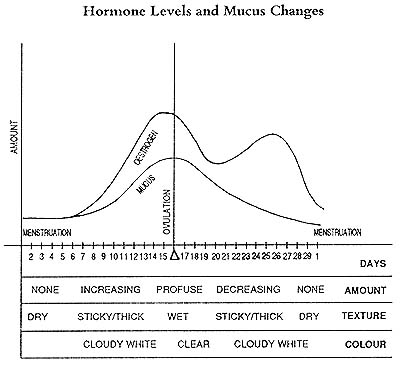Observing cervical mucus is simple. You are only interested in the mucus that is readily observable at the mouth of the vagina. You need only touch the mouth of the vagina (no need to touch inside), the outside of the opening or alternatively wipe the vaginal mouth with a tissue and feel mucus from that.
Dry or none = infertile,
Wet, profuse and slippery = fertile.
The changes from dry to wet indicate that fertile phase is coming, so either don’t have sex or use reliable contraception, (as the desire for sex increases with fertility, it is always a good idea to have contraception on hand) and changes from wet to dry indicate fertility is lessening.
Please remember that any presence of wet, (or whatever your experience of fertile mucus) fertile mucus is an indication of possible fertilityand coming ovulation… As sperm can live for up to 3 days in fertile mucus it is important / vital to not have unprotected sexual intercourse when fertile mucus is present if you do not want to get pregnant.
Sperm can be alive for up to 3 days in cervical mucus, if you have had intercourse in the lead up to ovulation when fertile mucus is present, the sperm can stay alive long enough for you to get pregnant. So knowing when your fertile time is coming is vital.
Factors like illness, intercourse (sperm left in vagina) and infection can all affect mucus observation, which is why proper instruction in these methods is vital.
The following diagram also shows the cycle of cervical mucus. Diagram is taken from Natural Fertility, pg 43.

Mucus observation is one indicator of fertility. The other time you can be potentially fertile is during your natal lunar phase.
What is a natal lunar phase?
|
The natal lunar phase is the angle between the sun and the moon at the time a person is born.
For example, if a person is born on a new moon, when the sun and moon are said to be conjunct or together, the natal lunar angle is 0 degrees. Conversely if a person is born on the full moon, when the sun and moon are opposite each other the natal lunar angle will be 180 degrees.
|
|
*********************
The section Two fertile times explains natal lunar phases in easy to understand terms
*********************
|
So every month as the moon goes through its changes, an individual will have their particular natal lunar phase repeated when the moon is in the exact position relative to the sun as it was at their time of birth.
For example, if a person has a new moon natal phase, the natal phase is repeated whenever the moon is new regardless of the moons zodiacal or astrological sign. This time is a potentially fertile one and a woman may spontaneously ovulate. Often these spontaneous ovulations are triggered by intercourse itself!
So it is much easier to keep an eye on your fertile time when your biological mucus cycle and your natal lunar phase co-incide. This ensures that fertility is limited to one episode per cycle. Also remember that if you do not desire a pregnancy abstain from sexual intercourse for 3 days before your natal lunar phase.
What about the Rhythm Method?
The rhythm method of guaging fertility are not very reliable, as ovulation does not always happen on day 14 or 15 etc.
If you are only counting days and not observing mucus, you run a real risk of missing your fertile time.
The temperature method only tells you when you have ovulated, not when you are going to ovulate.


